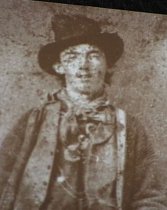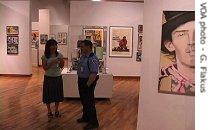2007年VOA标准英语-Billy the Kid Still Rides in New Mexico(在线收听)
Albuquerque, New Mexico
14 July 2007
The part of U.S. history commonly called "The Wild West" or "Old West," especially the colorful characters from the 19th century who were often at odds with the law, continue to fascinate people around the world. One such outlaw was Billy the Kid, who remains an iconic figure in the western state of New Mexico. He is the subject of an exhibit at the Albuquerque Museum of Art and History that runs through July 22. VOA's Greg Flakus spoke with the historian who served as curator for the show, and he filed this report from Albuquerque.
 |
| Paul Hutton |
The exhibit of paintings, photos and artifacts in Albuquerque's Museum of Art and History was put together by historian and University of New Mexico professor Paul Hutton. "I call this exhibit and the companion book I am doing for it "Dreamscape Desperado," because that is what Billy the Kid really is. He is the outlaw of our dreams," he said.
 |
| Photo of Billy the Kid |
 |
| Pat Garrett's gun |
Billy fought against a powerful and corrupt group in Lincoln County, New Mexico in a conflict that claimed around 100 lives. He was never a highwayman or robber, like Jesse James or Butch Cassidy, but he did kill several men, including four lawmen.
Hutton notes that, while he was despised by the corrupt men who wore the badges in those days, small ranch owners and Hispanics, in particular, saw him as a friend. "He is a 21-year-old kid, absolutely fluent in Spanish. (He) has lots of Hispanic girl friends and, in fact, in perfect romantic fashion, that is his undoing. He goes to old Fort Sumner to see his girl friend, Paulina Maxwell, when Pat Garrett tracks him down and kills him," he said.
Decades after his death, Hutton notes, the Kid's fame spread well beyond the western United States through comic books and movies. "Sixty movies have been made about Billy the Kid. I do not think there is another character in all of world history that has had that many films made about him," he said.
One of the most popular films made about the outlaw was 1973's "Pat Garrett and Billy the Kid," directed by Sam Peckinpah, with Kris Kristoferson in the role of Billy the Kid.
 |
| Exhibit Hall at Albuquerque Museum |
"It is so interesting that in America, which is a nation that constantly spouts themes of law and order, that we so romanticize the outlaw, but that is nothing new, people do that all around the world, whether it is William Tell or Robin Hood or Dick Turpin. The outlaw is a favorite subject and we all like the bad boy," he said.
Hutton says the Kid also represents the lone fighter, standing up to political power and defending a way of life threatened by industrialization.
"There was quite a bit of class conflict that went on, and there was also a struggle over sort of the machine coming into the garden, there was the last stand of the pastoral. Billy the Kid represents, in many ways, those pastoral themes. He also represents that lawlessness of the West, that refusal to compromise, the refusal to obey the rules that are imposed," he said.
As Paul Hutton wrote in an article about him some years ago, Billy the Kid is "the outlaw of our dreams -- forever free, forever young, forever riding."